

[
] 232
A
daptation
and
M
itigation
S
trategies
vegetation period. Livestock farming will profit from this as well.
On the other hand, water supply will decrease in summer, weeds
and insects will become more of a problem and damage caused
by extreme events will increase. In particular, the increase in heat
waves and drought periods represents a major threat. As a conse-
quence, the demand for irrigation will increase in many regions.
These risks could be reduced by the diversification of farms and
more extensive insurance coverage.
If the average warming exceeds 2 to 3°C by 2050, the disadvantages
will outweigh the advantages. Water scarcity will increase during the
vegetation period, and faster plant development will result in reduced
crop quality.
Adaptation
The above examples illustrate the broad variety of natural and anthro-
pogenic systems likely to be affected by climate change in Switzerland.
In order to prevent or diminish adverse effects and to take advantage
of positive effects, it is necessary to develop an adequate adaptation
strategy and implement appropriate measures.
In its climate legislation, Switzerland plans to include adaptation
as a complementary second pillar to mitigation. While adaptation
measures will effectively be implemented on a local to regional level,
it will be the task of the federal government to provide guidance and
to take the strategic lead. The latter will include:
• The provision of sound scientific knowledge regarding the future
development of the regional climate
• The identification of risks and opportunities brought about by
climate change
• The definition of adaptation goals
• The coordination of the various fields of action
• The development of different possible adaptive
measures for the various fields of action
• The evaluation of these measures in terms of effec-
tiveness and cost efficiency
• The prioritization among the different fields of
action and among the different possible measures
• The support of their implementation
• The evaluation of these measures after their imple-
mentation.
The overall goal will be to achieve the best possible
adaptation with the limited resources available.
Switzerland has begun this process with the devel-
opment of a national adaptation strategy. Scientific
information on climate change will form the backbone
of this strategy. A survey conducted by the Federal
Office of the Environment among its offices showed
that high resolution climate scenarios and reliable
scenarios of future developments of extreme events,
are essential for detailed impact analyses and planning
of adaptation in all fields of action. For instance: relia-
ble scenarios of extreme precipitation events and river
runoff are needed to optimize flood protection; reli-
able scenarios of water availability and droughts are
needed to guide the adaptation of protection forests to
a drier climate; reliable temperature and precipitation
scenarios are needed in agriculture to decide which
crops should be cultivated; and reliable scenarios of
future river discharge are needed to assess the coming
availability of hydropower.
Until now, national climate data has been provided
by the Federal Office of Meteorology and Climatology
(MeteoSwiss), and research has been mainly conducted
by research programmes such as the National Centre of
Competence in Research Climate.
4
However, since climate
information will be required more frequently in the future,
it will be essential to update such information on a regular
basis. For this reason, MeteoSwiss and the Center for
Climate Systems Modeling at the Swiss Federal Institute of
Technology will jointly calculate periodical climate change
scenarios at the regional level. Furthermore, climate obser-
vation and the statistical analysis of observational data
will be intensified in order to improve scenarios of future
climatic extremes (see also
Challenges for the Climate
Services in Switzerland
within this publication).
The survey among the federal offices also showed
a substantial need for adaptive measures to be imple-
mented within the next few years. For instance, climate
observation needs to be optimized, monitoring systems
for vector-borne diseases need to be set up, and more
structural measures for protection against thawing
permafrost need to be built. These additional meas-
ures require significant financial resources. However,
compared to the cost of inaction – estimated in a previ-
ous study to amount for 0.2 per cent of GDP in 2050,
and predicted to increase to about 0.5 per cent of GDP
by the year 2100
5
– this cost is very modest.
As a result of climate change, the snow line in winter is expected to rise and ski
resorts in the foothills of the Alps will struggle increasingly to operate profitably. The
need for adaptive measures will increase as climate change continues. However,
some measures require vast investment, while others will become less effective –
such as artificial snow production at low altitudes
Image: H. Müller, Forschungsinstitut Freizeit und Tourismus, Universität Bern
















